Only insignificant parts of the land thaw on stony and marshy soils, where you can find small "oases" - isolated areas with crustacean mosses, lichens, as well as herbaceous plants (sow thistle, cereals). In these harsh conditions of the kingdom of eternal snow and ice, there are even some flowering specimens of typical endemics - in the form of an Alpine foxtail (Latin Alpine alpinus), Arctic pike (Latin Deschampsia arctica), buttercup (Latin Ranunculus sulрhureus), snow saxifrage (Lat. Saxifraga nivаlis), polar poppy (lat.Papaver polare), diluting the scarcity of the surrounding nature with bright strokes.
Mushrooms and berries (cloudberries, cranberries, lingonberries) are rare.
The entire main flora of higher arctic plants does not exceed 350 species.
Character flora the ice zone is an arctic desert, broken cover (total coverage approximately 65%). On mountain tops, on inner plateaus and moraine slopes, the coverage area is no more than 1-3%.
Although the vegetation in the arctic deserts is poor and monotonous, you can notice a change in its character if you move from northern to southern borders... The north of Franz Josef Land, Severnaya Zemlya, the north of Taimyr is the territory where the grassy-moss arctic desert is developed. In the south of Franz Josef Land, the northern island of Novaya Zemlya, the New Siberian Islands, you can observe depleted shrub-moss arctic deserts, the vegetation cover of which includes low shrubs of polar willow (Latin Salix polaris) and saxifrage (Latin Saxifraga oppo-sitifotia). In the south of the ice zone, the most widespread arctic deserts are the dwarf-moss type, in which the dwarf shrub layer of the arctic willow (Latin S. arctica), polar willow, and dryad (Latin Dryas punctata) are well developed.
Low summer temperatures, scarce flora and permafrost layer interfere with the normal soil-forming process. During the season, the thawed layer does not exceed 40 cm. The soil thaws only in the middle of summer, and by the beginning of autumn it freezes again. Waterlogging during the thawing period and drying out in summer lead to cracking of the soil cover. In most of the Arctic, there are almost no formed soils, but only coarse detrital material in the form of placers. Lowlands and their fine earthy soil are the basis of arctic soils (very thin, without any signs of clay formation). Arctic ferruginous, slightly acidic, almost neutral, soils are brown in color. These soils are complex, associated with microreliefs, soil composition and vegetation. Scientific quote: "the main specific feature of the Arctic soils is that they are like a" complex "of soils with a normally developed profile under plant sod and with a reduced profile under algal soil films" gives full description arctic soils and explains the peculiarities of the flora of this region.
Productive vegetation in the Arctic is negligible. The total phytomass never exceeds 5 t / ha. The living aboveground mass sharply prevails over its underground part, distinguishing the Arctic desert, for example, from tundra, temperate or subtropical deserts with an inverse ratio of underground and aboveground phytomasses.
Algae (about 150 species) stand out as a separate group. The changed climate of the Arctic has dramatically changed the bottom ecosystems in the fjords of Svalbard: over 30 years, the algae cover there began to occupy an area 5-8 times larger when compared with the beginning of observations. If in 1995 the share of the Kongsfjord algae cover did not exceed 8% of its area, then already 1996 became abnormal for brown algae (which are called kelp, in common parlance - seaweed) - they suddenly occupied 80% of the total area, and since that time they have not inferior to the mark at the level of 40%.
Smeerenburgfjord was "captured" by both brown and red algae after 5 years. There, the algae cover has grown from 3% to 26%.
On the fjords, kelp has strongly pushed the previous dominants - anemones (sea anemones) and invertebrates.
The changed climate of the Arctic managed to reduce the stability of its bottom ecosystems, brought them out of a balanced state, and “opened”, that is, bottom ecosystems for more thermophilic species.
In addition, algae cause snow and ice to bloom. Their color is very diverse - from green, yellow, blue, brown to black, which depend on the presence in them of some kind of snow algae and other microorganisms.
Only "ice" diatoms in northern zone seas are now recorded about 80 different species.
Such algae can adapt to extremely unfavorable living conditions in low temperatures Oh. When they are in very cold surface layers of snow cover and glaciers, they experience very strong cooling from winter air temperatures of several tens of minus degrees, and in summer they can multiply in melted ice water, at 0 ° C. Scientists cannot explain this: for example, snow Chlamydomonas has a dormant stage with round thick-walled cells, and many other algae, including diatomy, have no special adaptation to withstand such low temperatures.
These algae of snow and ice belong to the vast majority of organisms that settle in frozen substrates. This type of substrates received the general name cryobiotopes (from the Greek cryo-cold, and topos - place), and their settlers are called cryobionts.
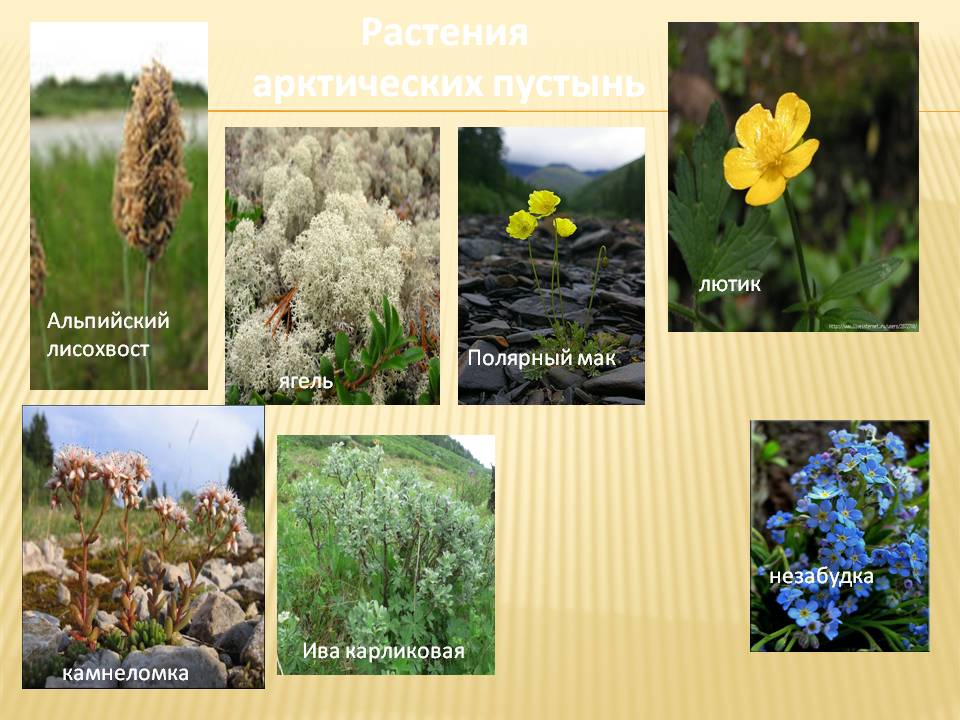
Arctic desert- the northernmost natural area. Despite the unfavorable growing conditions, there is still an insignificant part of the vegetation. Today we will consider typical plants of the Arctic deserts of Russia, that is, they are often found in the conditions of this region.
Peculiarities climatic zone Arctic
The climate of the Arctic desert can be described in two words - eternal winter. Although theoretically there is summer, the temperature at this time of the year does not rise above +5 degrees. In the summer in the Arctic, snow melts a little, due to which the earth is at least slightly moistened. It is interesting that the soil layer is thawed out over the summer by only 40 cm in depth, nothing more. Winter lasts almost constantly, and the air temperature here usually fluctuates within -35 degrees, but often drops to -60.
The land in this area is practically not illuminated by the sun and does not warm up. In addition, there is little rainfall here. Despite the severity of this climatic natural area, there is still vegetation here. It is difficult to call the local flora rich, but still some plants are so hardy that they can survive in such difficult conditions. Let's get to know them.
What plants grow in arctic deserts?
I would like to note right away that you will not find shrubs and trees in the Arctic. The wind is too cold, so the plants cannot "stick out above the ground" and remain alive. So mosses and lichens predominate there, as well as various algae. Almost half of the Arctic desert is not covered with vegetation at all, but consists of rocky soil and ice. The soil as such, even if it is found in the Arctic desert, is covered with iron and manganese oxide on almost the entire surface layer. That is why the earth here has a characteristic reddish-brown hue. Soil islands are usually occupied by sparse vegetation. The land near the ocean contains salt, so it is deserted.
Mosses and lichens
Almost 3 percent of the total area of the Arctic desert is occupied by mosses and lichens. They "settle" in areas protected from strong winds. In the northernmost part of this natural zone, only some species of lichens can grow - informal, cladonia and parmelia. Sphagnum mosses can also be found here. Where the arctic desert borders the tundra, the number of mosses and lichens increases significantly. In this strip, this vegetation already covers 60 percent of the soil.
The highest representatives of the flora of the Arctic deserts
In addition to mosses and lichens, some of the highest representatives of the flora have adapted to the extreme conditions of existence in the Arctic. They are found in places well protected from the wind, and their distribution is focal. Some desert ice plants even delight with their short flowering. All vegetation in this area has distinctive features- a root system that penetrates shallowly into the ground and is short. Let's talk about them in more detail. What kind of Russian plants are they that could grow here?
Poppy polar
Polar poppy is a perennial plant found in the Arctic deserts of Russia, mainly in the Urals (polar regions), in Yakutia and the Magadan region. This representative of the flora of the Arctic does not reach a height of more than 15 cm. It grows on stony soils. During a short summer, it pleases with its bright yellow and orange colors.
Arctic pike
A herbaceous plant with a hardy root system, which is a low (up to 30 cm in height) panicles with leaves at the base. The deciduous part is green, above the soil layer, at the roots, there are many leaves. With the onset of winter, they die off and form a thick layer of brown scales around the plant. The plant produces spikelets up to 15 cm long, erect, dense.
Arctic buttercup
This plant prefers humus-rich soil, so it can be found near bird colonies or near lemming burrows. Buttercup, like all representatives of the Arctic flora, is a stunted plant. It blooms with yellow flowers, either single, or collected in inflorescences.
Snow saxifrage
Snow saxifrage is a groundcover perennial plant that grows in the Arctic desert. Reaches a height of no more than 20 cm, covers the entire free space of the soil with a small-leaved carpet. During flowering, the snow saxifrage is covered with small white flowers resembling stars. Due to its frost resistance and unobtrusive beauty, the plant is successfully used as a decoration for alpine slides.
Sedge
The herb of the Sedge family is widespread almost everywhere, it can be found on almost all continents. In the Arctic deserts of Russia, it grows both in the Arctic and in areas bordering on tundra forests. Sedge is completely unpretentious, and due to its ability to withstand low temperatures, it is often used in landscape design. This herbaceous plant grows on stony soils and rocky slopes. Some species of this herb are listed in the Red Book as endangered.
Plants of the Arctic deserts of Russia are not so numerous, but the variety of species of grasses, plants and shrubs increases with approaching the tundra zone. In this part, the flora becomes much richer. All arctic herbs are amazing - being in harsh conditions, they delight us with their resilience and delicate beauty, which even eternal ice cannot destroy.
It is located on the northernmost edge of Asia and North America, including all islands in the Arctic basin that are included in the polar geographic zone... The climate is arctic, with long and harsh winters; summers are short and cold. There are no seasons. During the polar night - winter, and during the polar day - summer. Average temperatures are -10 to -35 °, dropping to -50 °. In summer - from 0 ° to + 5 °. Little precipitation (200-300 mm per year).
Vegetation is scarce, therefore animal world the arctic deserts are relatively poor: these are the arctic wolf, seal, walrus, seal, lemming, musk ox (musk ox), arctic fox, polar bear, reindeer, etc .; from birds - guillemots, puffins, eiders, rose gulls, snowy owls, etc. A separate group includes cetaceans, for which the conditions of the Arctic do not create any problems.
Birds of the Arctic deserts
The most numerous inhabitants of the harsh northern region are birds.
The rose gull is a fragile creature, weighing 250 grams, and a body length of 35 cm, feels confident enough and freely spends severe winters in the tundra, or over the sea surface, which is covered with drifting ice floes. Often joins the meals of larger predators.
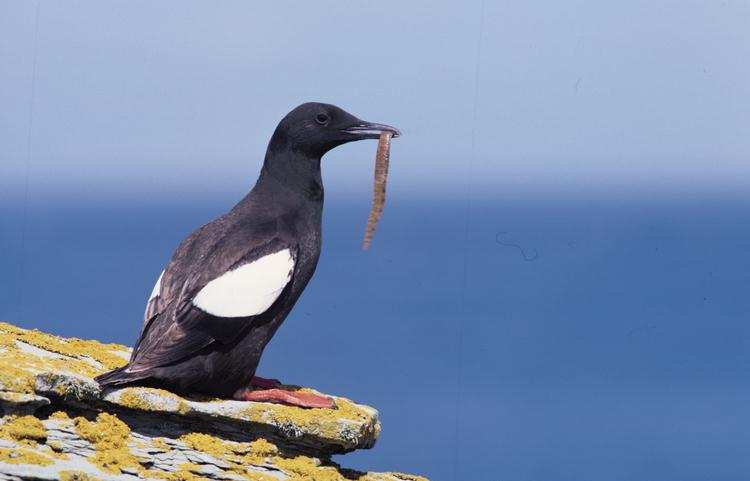
Guillemot is a black-and-white bird that nests on high steep rocks and spends the winter in ice, without experiencing any special discomfort.

The common eider is a northern duck that can easily dive in icy water to depths of up to 20 meters.
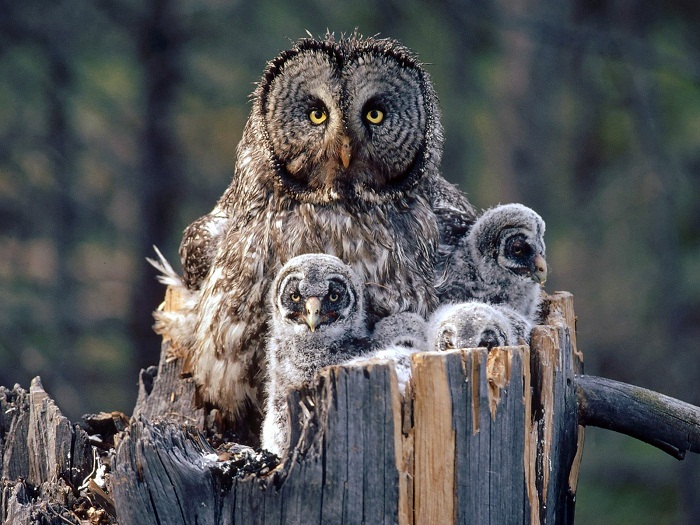
The most ferocious and largest of the birds is the snowy owl. A ruthless predator with beautiful yellow eyes and snow-white plumage hunts other birds and rodents, and sometimes the cubs of larger animals, for example, Arctic foxes.
Typical animals of the arctic deserts:
Cetaceans
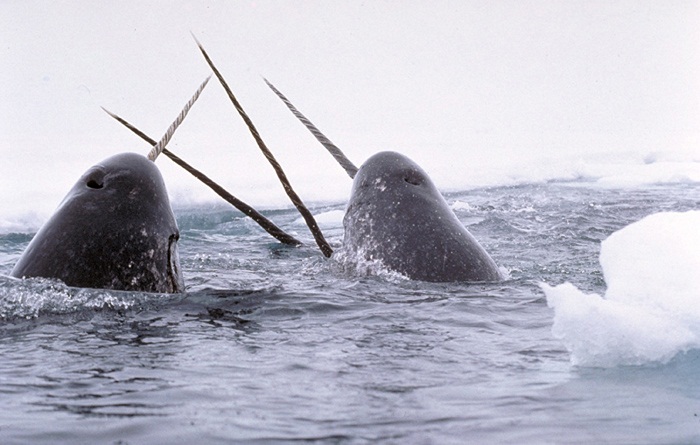
The narwhal is interesting for its long horn protruding from the mouth, which is an ordinary tooth, only with a length of 3 meters and a weight of 10 kg. Photo: One for all and all for one 🙂
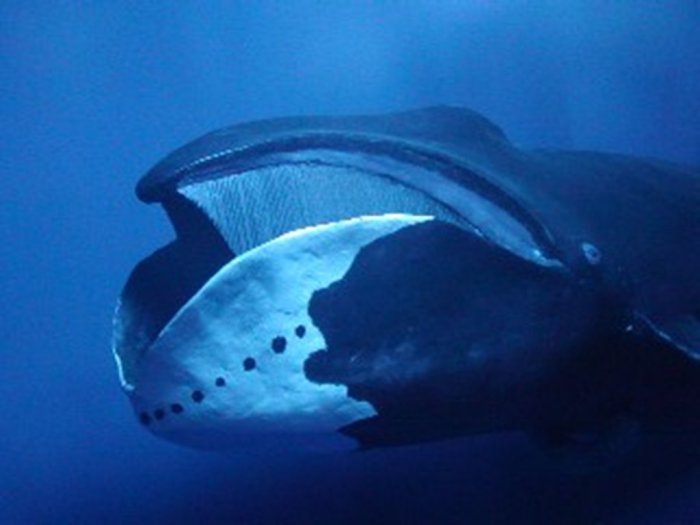
The bowhead whale is a relative of the narwhal. But he is many times larger than him, and instead of a strange tooth, there is a whalebone in his mouth with a huge tongue, which is convenient for licking off stuck plankton.
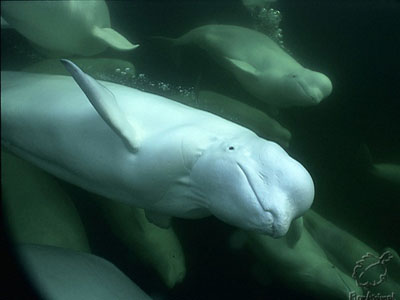
The polar dolphin or beluga whale is a large animal weighing up to 2 tons, with a length of up to 6 meters, which feeds on fish.

The killer whale ranks first among the largest and most powerful marine predators in the Arctic waters, where it hunts beluga whales, walruses, seals and seals.
Beasts

Seals are animals that make up a special Arctic cohort that has been living in this region for thousands of years.
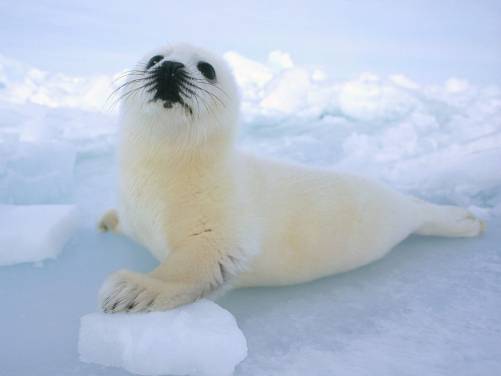
This species includes the harp seal with a very beautiful patterned skin.

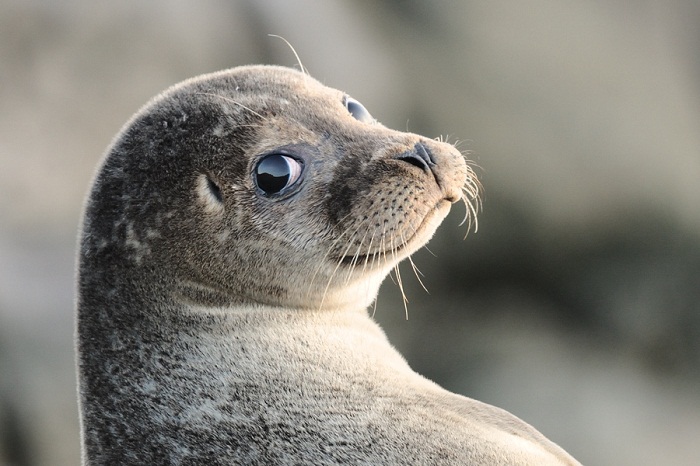
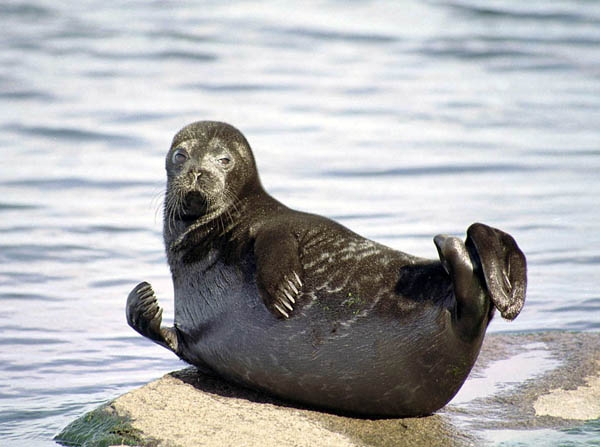

The sun's rays only glide along their surface, giving little heat, because the sun never rises high here (Fig. 2).
Rice. 2. Arctic Sun ()
The Arctic has a very harsh climate: snow and ice lie almost all year round, winters are very long and frosty (up to -60 °), hurricane winds blow, and a blizzard rages for several weeks in a row. From mid-October, the sun is no longer visible - the long polar night begins (lasts up to 6 months). Sometimes during the polar night there are polar lights, which last from several minutes to several days and are so extensive that their light is sufficient even for reading (Fig. 3).
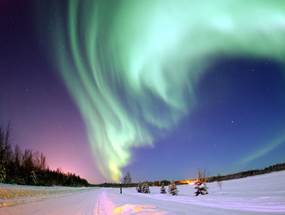
Rice. 3. Aurora Borealis ()
At the end of February the sun appears and the day begins to arrive. And from mid-May to mid-June, the sun does not hide at all - the polar day begins. But even at this time, the temperature rises only a few degrees above zero.
The islands are so poor in vegetation that they are called arctic deserts... On the stones meet moss, lichens, polar poppy and some other plants (Fig. 4-6).
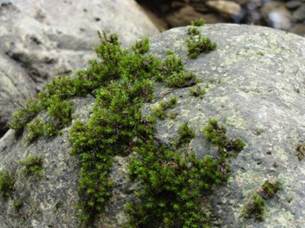
Rice. 4. Mosses on a stone ()
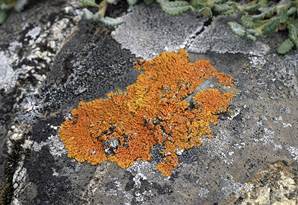
Rice. 5. Lichens on the stone ()
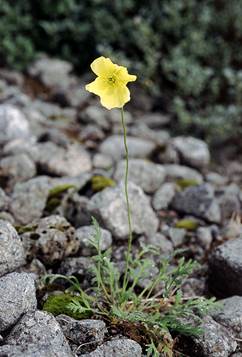
Rice. 6. Polar poppy ()
All plants here are dwarfs, their height is no more than 10 cm, only polar willow reaches 1 m (Fig. 7).
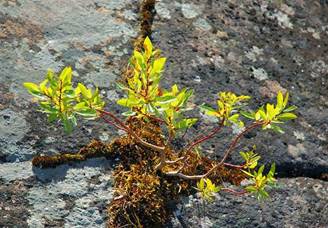
Rice. 7. Arctic willow ()
But all plants, protecting themselves from the cold and wind, are forced to cuddle to the ground.
The sea feeds all the inhabitants of the ice zone. In water rich in oxygen and carbon dioxide, they actively reproduce algae and crustaceans- the first link in the food chain arctic zone(fig. 8).

Rice. 8. Algae, crustaceans and other inhabitants of the ocean ()
They feed on fish and birds. The birds gather in large flocks, settle on the rocks, and, despite the tightness and size of the flock, each bird unmistakably finds its nest (Fig. 9).

Rice. 9. Nesting guillemots ()
Guillemots- noisy birds that nest on sheer cliffs, where no animal can reach (Fig. 10).
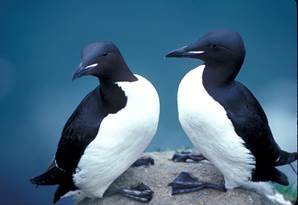
Guillemots hatch only one cone-shaped egg each (this shape protects the egg from falling from high cliffs). When the chick grows up, the guillemot throws it into the water, where its adult life begins: guillemots are excellent swimmers and divers (in the water they develop speeds up to 20 km / h, reaching a depth of 140 m).
Seagulls also adapted to the conditions of the Arctic: they fly well, swim well, but dive poorly (Fig. 11).
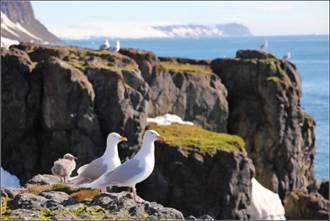
On some islands, you can see a huge number dead ends(fig. 12).

These are beautiful silent birds with an unusual beak. For living, they choose islands with a thick layer of peat, in which they dig their nests with the help of clawed paws and beaks. A dead end is an excellent getter: it can stay under water for up to 30 seconds, chasing fish, and bring up to 10 fish to the nest at a time.
Another food chain is algae - crustaceans - whales(fig. 13).

These huge animals are perfectly adapted to life in the ice zone: a waterproof hide and a thick layer of fat under it protect them from the cold.
Seals- one more inhabitants of the Arctic, live both on land and in water (Fig. 14).
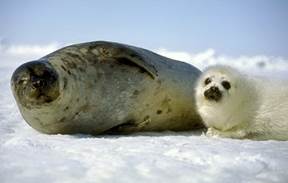
They are great swimmers. They need up to 16 kg of food per day. At the end of winter, seals give birth to snow-white cubs - seals. The white color helps kids to hide, disguising themselves as snow in order to escape from enemies, primarily from a polar bear. And adult seals escape from their main enemy in the water, because on land they are slow and clumsy.
Polar bear called the king of the Arctic, the great traveler and hunter (Fig. 15).
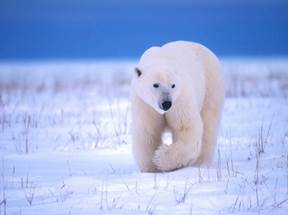
Rice. 15. Polar bear ()
This animal has perfectly adapted to life in the ice zone: it is fast and agile on land and in water, strong, it has an excellent sense of smell, thick white hair and wide paws with sharp claws. Like all inhabitants of the Arctic, he has small ears - so as not to freeze. For the winter, female mothers lie in snow dens, where cubs are born to them (most often there are two cubs, they are small, the size of a mitten). The mother bear feeds and warms them. In the spring, the cubs will leave the den, but for another two years the bear will teach her cubs to fish, hunt seals and much more (Fig. 16).
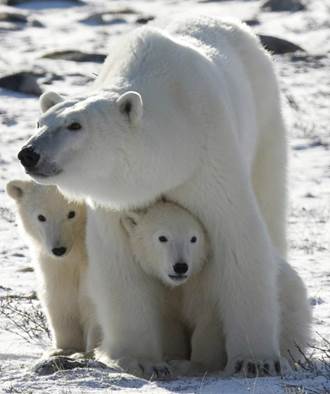
Rice. 16. Polar bear with cubs ()
The fauna of the Arctic is unique. A nature reserve was created on Wrangel Island - here are the largest concentrations walruses(fig. 17).
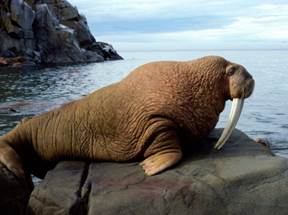
Walrus tusks- a universal weapon in the production of food and a weapon in defense from the enemy, as well as an insignia (who has the largest and most powerful tusks, he is the main one). There is a thick mustache on the face of the walrus - vibrissae- with the help of which they find food at the bottom of the sea (Fig. 18).
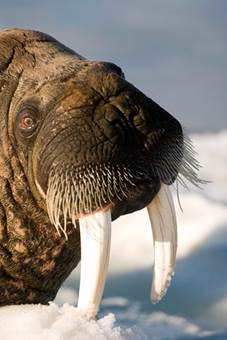
Rice. 18. Vibrissae on the walrus face ()
You can also see in this reserve musk ox(fig. 19).
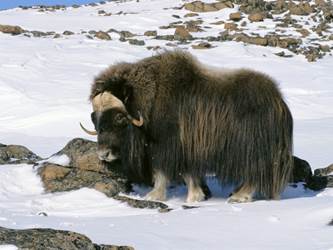
Rice. 19. Musk ox ()
Once they lived on the territory of Russia, but then they disappeared, and scientists brought them to Wrangel Island from North America (this is how rare and endangered species of animals are preserved).
This reserve is also called the maternity hospital of polar bears - bears come here from all over the Arctic, scientists count up to 250 dens per year.
For many years, the Arctic has been attracting people who, risking their lives, in extreme conditions, explore its expanses, make maps (Fig. 20).
Bibliography
- Vakhrushev A.A., Danilov D.D. The world around you 3. - M .: Ballas.
- Dmitrieva N.Ya., Kazakov A.N. The world around us 3. - M .: Publishing house "Fedorov".
- A.A. Pleshakov The world around us 3. - M .: Enlightenment.
- Geo-site.ru ().
- Biofile.ru ().
- Do.gendocs.ru ().
Homework
- Write a short quiz (6 questions with three possible answers) on the Arctic Desert Zone.
- Prepare small message about one of the animals in the Arctic.
- Think how you would change appearance and the habits of a brown bear, if he lived in a zone of arctic deserts.
- * Using the knowledge gained in the lesson, compose a small (10 questions) crossword puzzle on the topic "Arctic".
Low temperatures, strong winds and blizzards, snow cover that lays all year round or thaws only for a short time - these are the main conditions that determine life in the polar regions.
Polar deserts
Zones of arctic and antarctic deserts are common in the arctic and antarctic. They formed during the long polar night and extremely low temperatures. Only 10-12 days a year the temperature rises above 0 С, and the topsoil has time to thaw for a short time.
Most of the territory is occupied by glaciers. In ice-free areas, mosses and lichens grow. There are only two types of flowering plants, and in the Arctic there are slightly more of them. Among the arctic species, the polar poppy, snow buttercup, and saxifrage are widespread. In primitive arctic soils there is almost no humus horizon.
The fauna of the arctic deserts is poor. Only on the rocky coasts in summer the life of noisy bird colonies is in full swing, where guillemots and auk nests, gulls and guillemots nest. On the coasts there are large animals (walruses, seals) that feed on fish and crustaceans. In the Northern Hemisphere, the Arctic is home to large mammals - polar bears. Their main food is fish and seals. V Southern hemisphere In the harsh climate of Antarctica, penguins nesting on coasts in Antarctic oases, where the air temperature is higher than in the surrounding area, feel best.
Tundra
Tundras are common in Eurasia and North America... In Russia, they occupy the second place in terms of area after the taiga. In the Southern Hemisphere, tundra is almost absent.
A typical tundra is a treeless area with low and not always continuous vegetation cover. The main vegetation of the tundra is mosses and lichens. Dwarf birch, polar willow, partridge grass also grow here. They, as if clinging to the ground, form a kind of "pillows". Many shrubs - lingonberry, cloudberry, cranberry - are evergreen. In the short summer, the tundra blooms. The soils of the tundra are often swampy and extremely poor in humus, but rich in semi-decomposed plant remains - peat.
The fauna of the tundra cannot be called diverse. On the shores of tundra lakes, polar geese, swans, and waders nest. Numerous inhabitants of the tundra - lemmings - are the main food of arctic foxes and polar owls.
The largest animal of the tundra is the reindeer. It feeds on lichen lichen. Many animals and almost all birds move to forest zone... The forest-tundra stretches along the border of the tundra in a narrow strip. It is an alternation of areas of tundra and forest.




